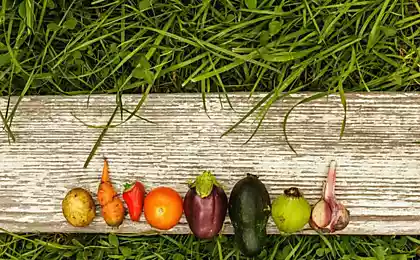816
What do raw foodists eat ?! The rich menu!

Many people far removed from the raw food diet are surprised: "What did you eat? You also can not be anything! "But in fact, raw foodists menu is very rich, there is always plenty to choose from!
1. Vegetables. Everyone knows a huge amount of vegetables. The only thing you need to pay attention, because this is the fact that the cauliflower, broccoli, artichokes and pumpkin raw taste better than boiled.
2. Fruits. Fruits like everything - raw foodists and vegans and meat-eaters. Raw foodists prefer fruits that grow in the native areas in their native land and those that match the season. But sometimes indulge themselves and overseas fruits, such as oranges, bananas, kiwi, avocado.
Exotic fruits should not be more than 10%. Sometimes, when like some fruit, it is best to eat it,
3. Berries. Strawberries, cherries, strawberries, cherries, watermelon - and everything else that can be found on your market, gardens or forests
. 4. Menu Raw foodists do without dried fruits. The best dried fruit - a dried fruit that are dried in a dehydrator at low temperature
. 5. Med. It is believed that honey - a product of animal origin, but most raw foodists consume honey in large quantities
. 6. Vegetable oil. Linseed (containing omega fats), sesame (containing calcium), olive oil, pine nut oil and others. The oil may be any, the main thing that it was oil first cold pressed.
7. Seaweed - one of the favorite products of raw foodists. This vitamins, proteins, polysaccharides and fats. Like big dry sea kale, because the rest of the most chemistry, vinegar and toasted. Raw foodists sea cabbage soaked in water, add the oil - and tasty salad ready to eat
. 8. Fresh herbs: herbs and leafy vegetables. Celery, lettuce, parsley, sorrel, fennel, nettle, dandelion, spinach, quinoa and rhubarb - this is not a complete list of herbs that are very useful and tasty. They just love to raw foodists and made from them a lot of useful and tasty dishes. Note wild grasses - they have a lot of vitamins and minerals, macronutrients and micronutrients because the body needs
. 9. Nuts. The most different and varied: almonds, walnuts, hazelnuts, pine
. Seasoned raw foodists do not recommend to buy cashews and pistachios, as they are sold only treated - fried, as, for example, cashew impossible to clean and maintain for a long time without treatment. Another recommendation - it is desirable to buy nuts in the shell, as the shelled nuts "grows" mold, the use of such shells are very beneficial to the health
. Nuts are a good soak before use, then they will get the taste of young nuts.
10. Germinated beans: peas, mung bean, lentil, chickpea. Legumes can be added to a salad.
11. Germinated grains: wheat, rye, oats, corn. Cereal is also added to salads. During the transition period can be added to grain honey and dried fruits.
12. Buckwheat green. Buckwheat store shelves - it's fried buckwheat. Green buckwheat is ready for use in an hour after soaking, it can exist in a dry form.
13. A variety of seeds: pumpkin, sunflower and others. Seeds can also be soaked, very useful and tasty sprouted sunflower seeds. Germinated seeds give a lot of energy.
14. Alfalfa sprouts seeds, vetch, flax, poppy, thistle, amaranth, sesame, etc.
Bon Appetit! Good luck and stay healthy!
INCENTIVES FOR TRANSITION TO raw food diet Zealand.
Living without meat | To eat or not to eat meat athletes?























